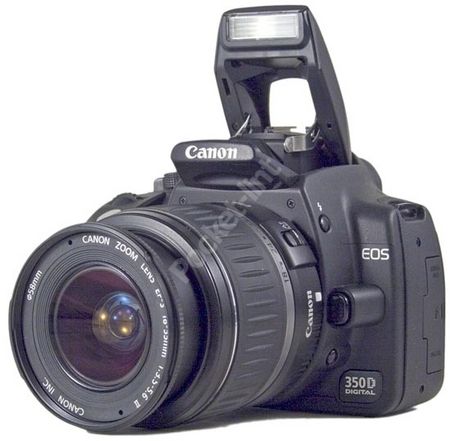With every camera manufacturer slowly getting into the entry level digital market does Canon’s latest entry-level offering still stand up against the competition? We put it to the test for a gruelling weekend of high-octane sport and celebrity spotting at the Monaco Grand Prix.
Up against its predecessor, the 300D, the 350D has come on leaps and bounds. The casing has been changed to a matte plastic finish rather than the silver (you will be able to get silver if you want from Jessops, as a Jessops exclusive) and this instantly makes it fill like you are playing with the big boys.
The camera’s measurements and weight have also been reduced considerably and the 350D is, according to Canon, some 17 per cent lighter than the 300D and 15 x 5 x 8 mm smaller in size.
This has its pros and cons; the pro being that its lighter and smaller to carry around with you, but the con being that any lens attached other than the supplied 18mm-to-55mm f/3.5-to-f/5.6 comes across as top heavy. We tested it with both the supplied lens and a traditional 35mm film lens; the Sigma 28-300mm and found the later awkward to use due to the weight distribution.
Get past the body weight and the new casing and you’ve got a good entry-level DSLR camera with the specs to match the price. Inside you’ll get an eight megapixel CMOS sensor with the same DIGIC II image processor found on the Canon’s top flight professional model - the 20D. This according to Canon gives faster processing, less power consumption and better image quality, and judging by the end results we would have to agree.
Because of the use of the DIGIC II image processor, the speed and amount of the continuous shots that can be taken has been increased from a poor four to a slightly better 14. This came in handy for not only catching the Formula One cars whizzing past, but also celebrities on the move. In some cases though, we would have liked the option of a few more shots before the buffer filled up and the camera froze. Not because we are avid sports fans wanting to make sure we catch all the action 14 times in one hit, but purely because of the nature of digital photography. For us the main point of digital photography is shoot for the now, and edit your choice later. With no fear over film or development costs, the premise of getting good blanket coverage is, in our mind, the best way forward to guarantee at least one good shot.
Using the camera was very straightforward. Menus were simple and easy to use and the different pre-set modes will appeal to the first time DSLR users without dummying down the camera. Of course there is plenty of optimisation available and everything from aperture to exposure can be manually set as you would expect. White balance fine tuning and bracketing has been improved although we did find the included flash slightly over compensated at times. Additionally the said flash was prone to scaring the hell out of the subject as it dramatically pops up before taking the shot.
Images themselves are crisp and full of colour coping with the array of subjects we tested it with. The cameras quick start up time and improved continuous shooting mode meant capturing the cars as they whizzed past at 180mph wasn’t really a problem. Likewise the accompanying 18mm-to-55mm lens proved a good starting ground for those not sure of what they want to shoot.
Our quick take
So should you upgrade, or more to the point, should you make the switch from analogue to digital? When we tested the 300D we were impressed, but not to the extent that we were willing to dump our 35mm Canon EOS 600 and make the switch.
The 350D changes all that. The camera is easy to use and offers the SLR enthusiast the chance to take plenty of pictures knowing that they can not only edit them when they get home, but also won't be faced with a hefty processing bill for pictures that perhaps haven't worked.
Photographs no longer held that “it might make an interesting picture but I don't want to waste the film” to “lets see what we get and delete it later if it doesn't work”. Because of this, it changed the way we took pictures and only for the better.
With a very competitive price (the RRP is £200 cheaper than the 300D when it launched) this certainly is one to consider and certainly gives the Nikon D70 a run for its money. If you're thinking of making the switch and you're on a budget, this will do the job.

Canon 350D Digital SLR - 4.5 / 5
| FOR | AGAINST |
|---|---|
|
|
To recap
As an entry level DSLR this is great stuff, providing great pictures with little effort in a lightweight body
